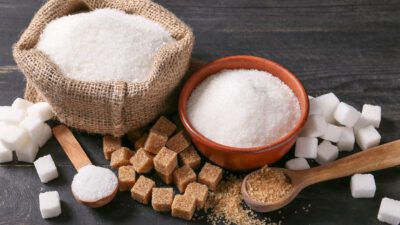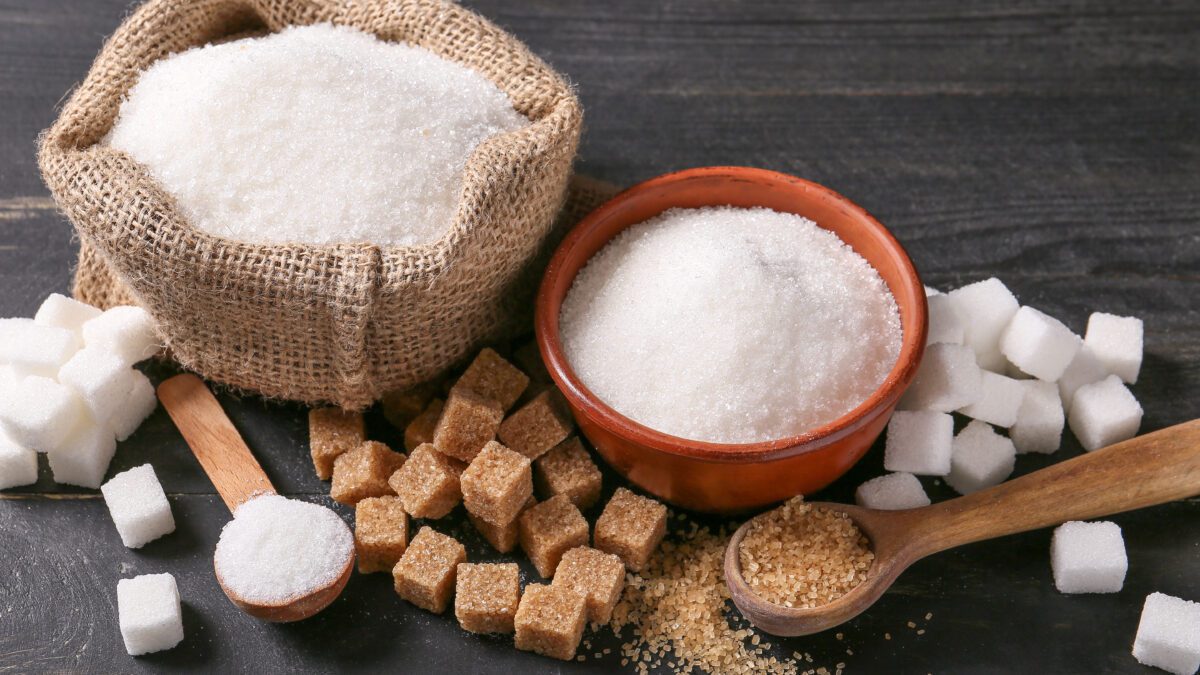



Sugar is full of ‘empty’ calories, is low in satiety value (so we need to consume a lot of calories from it to feel full) and is in fact an ‘antinutrient’ meaning it can deplete vital vitamins & minerals from our body.
We should all be working to eliminate added processed sugars from our diets and become more aware of some of the worst offenders for ‘’hidden’ sugars, both sweet and savoury!
Top offenders for ‘hidden’ sugar content can include ready meals, breakfast cereals, tinned soup, salad dressings, yoghurts, pasta sauces & table sauces plus soft drinks, coffees and juice drinks.
Make informed choices: Low sugar foods are those that contain less than 5g of sugar (not total carbohydrate) per 100g of product so always check the labels.
Re-train your taste buds to be less reliant on sweet-tasting foods & drinks rather than looking for equally sweet alternatives to satisfy the craving.
Artificial sweeteners may be free from calories but they can pose their own health risks when eaten in excess and ‘’fake sugars’’ have actually been associated with weight GAIN rather than weight loss. This is thought to be because when you eat something sweet, your body expects calories and nutrition, but artificial sugars don’t give your body those things so your body becomes confused and the hormonal response exerted leads us to crave more sugar (& calories).
(Yale Journal of Biology & Medicine review 2010 https://www.ncbi.nlm.nih.gov/pmc/articles/PMC2892765/0)
Sugar hides under several sneaky names, including high fructose corn syrup, dried cane syrup, invert sugar, molasses, brown rice syrup, sucrose (or any word ending in “-ose”). Even seemingly healthy products like yoghurts and breakfast cereals may contain multiple sweeteners. If several sugars appear on the label, it’s an indication that the food is less healthy than you may think!
Look for ‘unsweetened’ products rather than ‘’sugar-free’ or ‘’no added sugar’’ This ensures there are no nasty artificial sweetener chemicals hidden within the item .
Wean yourself off sugar gradually. If you are used to having two sugars in your coffees, go down to one and a half for a couple of weeks, then one, then a half and over a couple of months you may have been able to break the habit altogether!
Support your insulin function through nutrients to help crack sugar cravings. B vitamins, magnesium and chromium are all vital nutrients that work to control our blood sugar levels. Boosting these nutrients can help to regulate our appetite and reduce the dips in blood sugar that lead to cravings. Good sources include meat and fish, green leafy vegetables, whole grains, dairy products, eggs and legumes.
Pair protein, healthy fats, and fibre for your meals and snacks. These foods cause a slow rise in blood sugar and keep you feeing full for longer, decreasing the desire for sugar. Add walnuts to your porridge, smoked salmon & avocado to your toast and a piece of lean turkey or cheese with your mid-morning apple.
Excite other areas of your taste buds: To help remove the need for sugar, add extra flavours that we automatically associate with being sweet such as vanilla, cacao, mint, citrus, ginger, nutmeg and cinnamon. Cinnamon has actually been shown to naturally regulate blood sugar levels which can help to control your appetite.
(Journal of Medicinal Food 2011 https://www.ncbi.nlm.nih.gov/pubmed/?term=Davis+Yokoyama+Cinnamon)
Don’t be fooled by fluids: We all know fizzy drinks can be a major contributor of sugar (and empty calories) in our diets, but we’re not always as savvy at spotting the sugar-laden drinks that are supposed to be healthy! ‘Enhanced’ fruit waters, iced teas, pre-bought smoothies, energy drinks and coffees can contain just as much sugar (and more!) than the well-known soft drinks.
Have your cake and eat it! You can still enjoy the occasional sweet indulgence even with your resolve to slash sugar. Limit your daily quota using the tips above and reserve a sweet treat for a special occasion, or even better make your own healthy sweet treats such as raw chocolate brownies using some of the sugar alternatives coming up.
Learn more about sugar in our Nutrition and Weight Management course
References: Robert H. Lustig, Kathleen Mulligan, Susan M. Noworolski, Viva W. Tai, Michael J. Wen, Ayca Erkin-Cakmak, Alejandro Gugliucci, Jean-Marc Schwarz. Isocaloric fructose restriction and metabolic improvement in children with obesity and metabolic syndrome. Obesity, 2015; DOI: 10.1002/oby.21371
Magnuson, B. A.; Burdock, G. A.; Doull, J.; Kroes, R. M.; Marsh, G. M.; Pariza, M. W.; Spencer, P. S.; Waddell, W. J.; Walker, R. (2007). “Aspartame: A Safety Evaluation Based on Current Use Levels, Regulations, and Toxicological and Epidemiological Studies”. Critical Reviews in Toxicology. 37 (8): 629–727. doi:10.1080/10408440701516184. PMID 17828671.